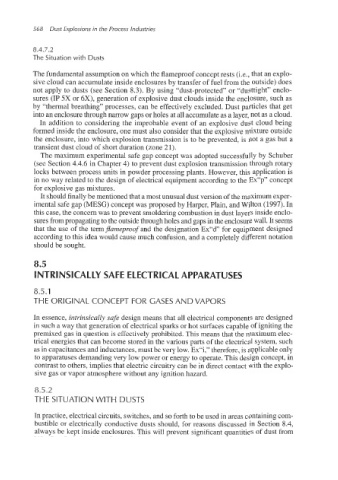Page 601 - Dust Explosions in the Process Industries
P. 601
568 Dust Explosions in the Process Industries
8.4.7.2
The Situation with Dusts
The fundamental assumption on which the flameproof concept rests (i.e., that an explo-
sive cloud can accumulate inside enclosures by transfer of fuel from the outside) does
not apply to dusts (see Section 8.3). By using “dust-protected‘’or “dusttight” enclo-
sures (IP 5X or 6X), generation of explosive dust clouds inside the enclosure, such as
by “thermal breathing” processes, can be effectively excluded. Dust particles that get
into an enclosurethrough narrow gaps or holes at all accumulate as a layer, not as a cloud.
In addition to considering the improbable event of an explosive dust cloud being
formed inside the enclosure, one must also consider that the explosive mixture outside
the enclosure, into which explosion transmission is to be prevented, is not a gas but a
transient dust cloud of short duration (zone 21).
The maximum experimental safe gap concept was adopted successfully by Schuber
(see Section 4.4.6 in Chapter 4) to prevent dust explosion transmission through rotary
locks between process units in powder processing plants. However, this application is
in no way related to the design of electrical equipment according to the Ex“p” concept
for explosive gas mixtures.
It should finally be mentioned that a most unusual dust version of the maximum exper-
imental safe gap (MESG) concept was proposed by Harper, Plain, and Wilton (1997). In
this case, the concern was to prevent smoldering combustion in dust layers inside enclo-
sures from propagating to the outsidethrough holes and gaps in the enclosurewall. It seems
that the use of the term flameproof and the designation Ex“&’ for equipment designed
according to this idea would cause much confusion, and a completely different notation
should be sought.
8.5
INTRINSICALLY SAFE ELECTRICAL APPARATUSES
8.5.1
THE ORIGINAL CONCEPT FOR GASES AND VAPORS
In essence, intrinsically safe design means that all electrical components are designed
in such a way that generation of electrical sparks or hot surfaces capable of igniting the
premixed gas in question is effectively prohibited. This means that the maximum elec-
trical energies that can become stored in the various parts of the electrical system, such
as in capacitancesand inductances,must be very low. Ex‘?,”therefore,is applicable only
to apparatuses demanding very low power or energy to operate. This design concept, in
contrast to others, implies that electric circuitry can be in direct contact with the explo-
sive gas or vapor atmosphere without any ignition hazard.
8.5.2
THE SITUATION WITH DUSTS
In practice, electrical circuits, switches, and so forth to be used in areas containing com-
bustible or electrically conductive dusts should, for reasons discussed in Section 8.4,
always be kept inside enclosures. This will prevent significant quantities of dust from

